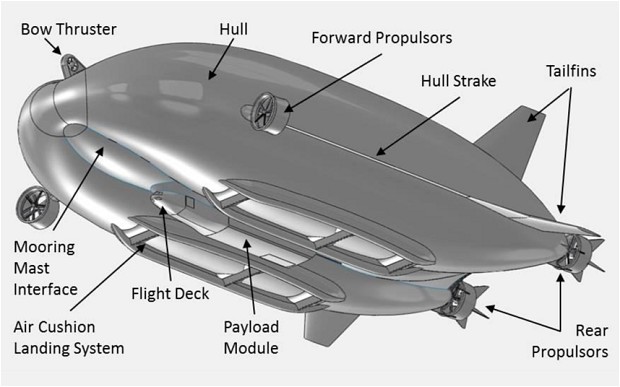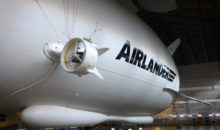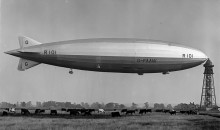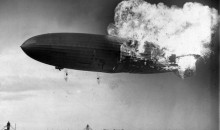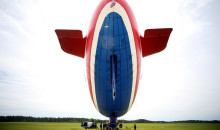World’s largest aircraft unveiled – hailed ‘game changer’
The world’s longest aircraft, consisting of part airship, part helicopter and part plane, has been unveiled and could be the key to greener more efficient planes in future as developers predict one day there could be as many of the hybrids as there are helicopters today.
The HAV304 which can stay airborne for up to three weeks and will be vital in delivering several tonnes of humanitarian aid as well as transporting heavy freight across the world, has been unveiled at Cardington Airship Sheds, the largest hangars in the world.
Long-time Balloonteam.net readers will remember we covered the fate of a US military surveillance project involving this aircraft back in October 2013.
The 300ft (91m) ship is part plane, airship and helicopter, and there are plans to eventually use it to transport hundreds of tonnes of freight across difficult terrain throughout the world as well as deliver aid to risky areas.
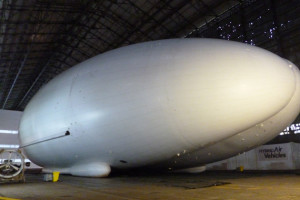
The HAV304 in its previous incarnation as the US Army Long Endurance Multi-Intelligence Vehicle during iflight tests at Lakehurst Naval Air Station.
It is environmentally friendly, being part airship filled with inert helium, and will also be used for surveillance and communications. Developers hope to make more of the ‘green vehicles’ which they hope to make capable of taking off from land, water, desert, ice and fields.
Hybrid Air Vehicles Ltd (HAV), which created the hybrid craft, said they expect there to be as many airships as helicopters in the sky in years to come as they provide an environmentally friendly and efficient solution to transporting dozens of tonnes of freight and reaching hard to access areas.
The company also expects to create ‘luxury’ hybrids, with infinity pools stretching across hundreds of feet, and planes being used for things like safaris and whale watching because they run on often just one engine so are quieter than traditional vehicles and can access hard to reach areas.
Chris Daniels, head of partnerships and communications at (HAV), said: “These do something nothing else does. There’s two variations – the ones that can stay in the air for a long period of time which can be used for things like communications and covering sports events.
“They also have a pseudo-military use. Rather than having a police helicopter which are noisy and can only stay up for a limited period of time, these can stay airborne for a long time and be as overt or not as people want.”
The latest hybrid, which cost about £30 million to make, will be used for communications but the company is set to start making an even larger version later this year which will be able to transport up to 50 tonnes of freight and passengers. It hopes the industry could eventually create around 1,000 jobs.
Mr Daniels said because of the way helium is used to power the ships, every time the length is doubled they can carry up to eight times as heavy a load. He hopes this will mean they can eventually make crafts capable of carrying up to 200 tonnes.
However he said he can’t see the ships replacing railways traditionally used to transport freight, but instead said the hybrid machines would be suitable for transporting very heavy loads in hard to reach areas like Canada and Africa. He added: “The climate change issue around ice roads in Canada mean another solution is needed, whereas with the security issue in Africa, this could solve part of the problem.”
Mr Daniels said several companies had expressed interest in hybrids so far, and they had also had a handful of enquiries from people who “just want one.”
He added: “Maybe one day it will be the case that people get the Orient Express one way and a hybrid aircraft on the way back.
“The only limit is people’s imagination.”
He said they will start building the larger version later this year, but hope to eventually be making them at a rate of around ten a year.
Bruce Dickinson, lead singer of Iron Maiden, compared the latest ship to Thunderbird 2 and described the craft as a “game changer.”
“It will be able to cross the Atlantic and launch things right where they need to be,” he told Radio 4’s Today programme.
“It can reach about 100mph and stay airborne for about three-and-a-half days.”

The HAV304 hull and mission module arriving at Cardington
He says he wants to generate publicity for the project and fly it round the world twice, and the company is currently running a comp
etition for people to fly on the larger ships maiden voyage – expected to take place in 2016.
The latest low carbon ship, known as the HAV304, is about 70 per cent more environmentally friendly than a cargo plane and doesn’t need a runway to take off.
It has been displayed at Cardington in Bedfordshire in the only hangar big enough to accommodate it, built 100 years ago.
It is due to fly in the UK later this year and the project has just received a £2.5 million Government grant to fund research into energy efficient and quieter planes.
Vince Cable, the UK Business Secretary, said:
“The growing aerospace sector has the potential to generate thousands of new jobs and billions of pounds to the UK economy in contracts.”
“That is why so much effort is being put in by government and industry to ensure we stay ahead of the competition and build on our strong position as second in the world for aerospace.”
The ship was first flown in the USA.
HAV plans to make between 600 and 1,000 of these type of airships in future and said similar projects are already being developed across the world in France, America, Russia and Australia.
It will eventually lead to the development of the Airlander 50, which would be able to transport 50 tonnes of freight and burn a quarter the amount of fuel of a plane doing the same job. This craft will be even bigger, with plans to make it 390ft long (119m), 196 ft wide (60m) amd 115ft (35ft) high – making it taller than both Big Ben, which reaches 315 ft (96m) and the Statue of Liberty which towers to 305 ft (93m.)
Plans for this hybrid also include fitting two hovercraft type vehicles to the bottom so it is capable of landing on water. There will also be space for 50 passengers on board.
Stephen McGlennan, chief executive, said: “This Government support shows that HAV has a credible way of solving one of the aerospace industry’s key challenges – creating a viable low-carbon aircraft which can travel for days and for thousands of miles without refuelling, landing without the need for airports.
“It is a great story of a British company leading the world.”
- The HAV304 is the world’s largest aircraft, measuring 302ft (92m) long – the equivalent of more than eight double-decker buses parked end to end.
- Its length means it is about 60ft longer than a Boeing 747.
- It measures 143ft (43.5m) in width and 85ft (26m) in height
- It can stay airborne for 21 days unmanned (five days manned) and reach altitudes of up to 20,000 ft (6,100m)
- The aircraft weighs about 22,050 lbs (10,000kg) when fully inflated
- The craft is capable of reaching speeds of 100mph
- The ship will eventually be capable of carrying 50 tonnes at a time, around 50 times more than a helicopter can carry.
- The vehicle is full of inert helium rather than hydrogen, as used the in the R101 hybrid airship.
- No runway is required for the craft to take off, and just a crew of two is needed.
- The aircraft was first developed for the American government as a surveillance craft but was affected by cutbacks to the defence budget.
- It was shipped to the UK in 15 containers, which took four days to unload.
- It is being stored at the largest hangar in the world, at Cardington. This is 812ft (248m) long, 157ft (48m) high and 180ft (55m) wide.
- The craft has been designed to be heavier than air, so that it doesn’t need people to hold ropes to land it
- The first British flight is scheduled for next year
The aircraft was previously known as the U.S. Army’s Long Endurance Multi-Intelligence Vehicle (LEMV) and was operated by Northop Grumman at Lakehurst, N.J. Here is a video of its maiden flight in August 2012.
via – Telegraph.


